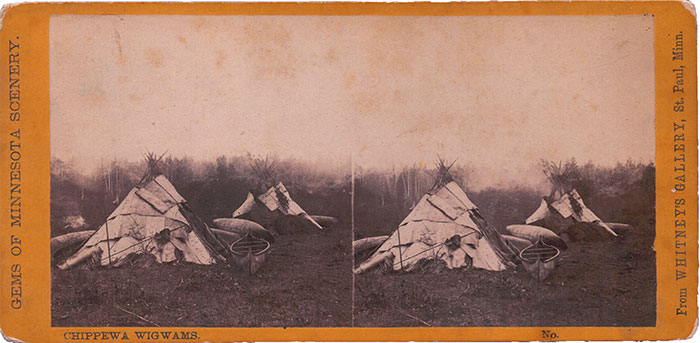Campsites/Villages

Stereograph of an Ojibwe Encampment in northern Minnesota (Collection of Turnstone Historical Research)
The protected coves and bays of the St. Louis River and its estuary offered many favorable locations for Native campsites.
5. Minnesota Point. Archaeological and documentary evidence indicates the traditional importance of Minnesota Point within the indigenous landscape. Needing no further identification, it is simply called Neiashi or Shagawamik, which is to say “a point of land. Its setting and natural resources made the point an ideal summer campsite and Ojibwe families continued to reside there seasonally through the nineteenth century. (Carlson 2015a; Winchell 1887:457)
6. Fond du Lac Campsite. The topographic setting of present-day Fond du Lac is an ideal setting for riverside campsites. Archaeological and historical accounts document the use of this area by Native people long before the American Fur Company chose to build at this location. While the fur post was in operation, an Ojibwe village and gardens were located nearby. (Carey 1898:11; Ely 2012:217)
7. Campsite and Landing Place. A Native campsite and landing place for canoes and boats is indicated midway between Minnesota Point and Rice’s Point on R.E. Carey’s map of 1865 Duluth. (Carey 1931:11)
8. Morgan Park Campsite. Local histories in newspapers from the first quarter of the 20th–century mention the presence of an Ojibwe camp within Duluth’s Morgan Park neighborhood. (Duluth News-Tribune, December 14, 1902, February 16, 1913; Duluth Weekly Advertiser, May 27, 1926).
9. Indian Point Park Campsite. An Ojibwe encampment on Crosier’s Point is the likely source of the name “Indian Point Park.” (Aguar 1971:7; Van Brunt 1921:140)
10. Wisconsin Point Campsite. Archaeological and documentary evidence indicate that Native people have used Wisconsin Point as a campsite and burial place for centuries. Among those who lived and was buried on Wisconsin Point was Chief Joseph Osaugie (1802-1876). Like Minnesota Point, Wisconsin Point, as a place of traditional importance within the indigenous landscape, was used and occupied by Ojibwe families into the twentieth century. (Wisconsin Archeological Society 1914:56)
11. Connor’s Point Campsite. Archaeological evidence gathered before 1914 indicates that prior to its development, Connor’s Point was used as a Native campsite. (Wisconsin Archeological Society 1914:56)
12. Nemadji River Winter Camp. The winter camp of Chief Osaugie of the Fond du Lac Band was located along the Nemadji River. (Superior Evening Telegram, August 28, 1951)
13. Nemadji River Campsite. An Ojibwe village was located near the mouth of the Nemadji River. (Superior Evening Telegram September 28, 1951; July 15, 1954)
14. Billings’s Park Campsite. Superior's Billing's Park neighborhood was the site of an Ojibwe camp along the St. Louis River. (Superior Evening Telegram, July 15, 1954)
Copyright © 2022. All rights reserved.


